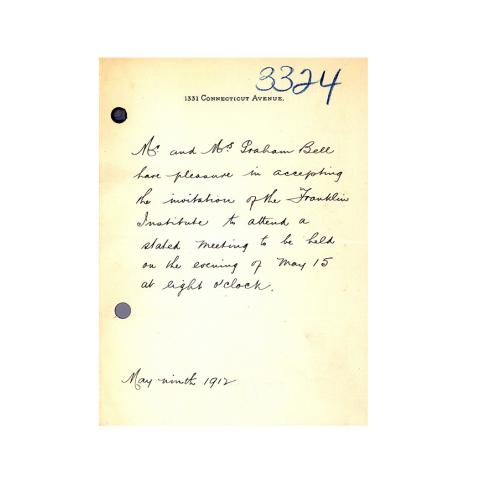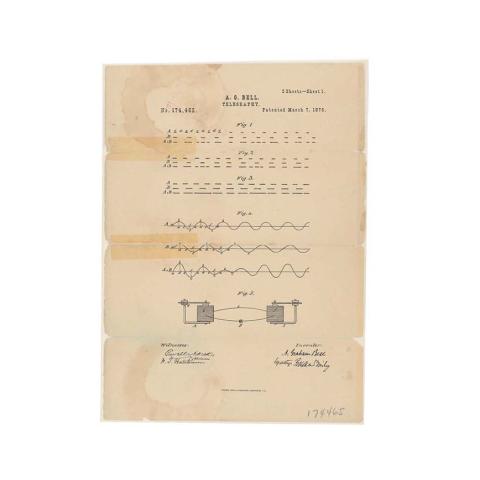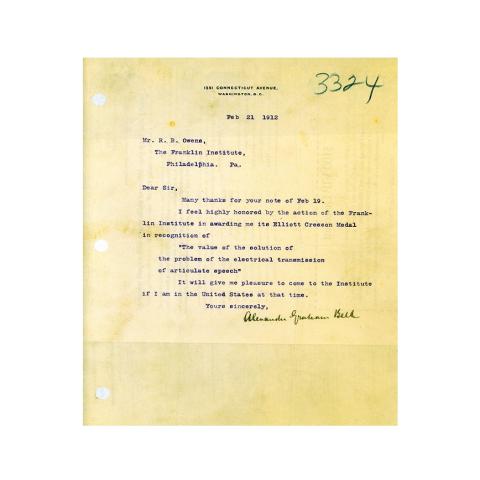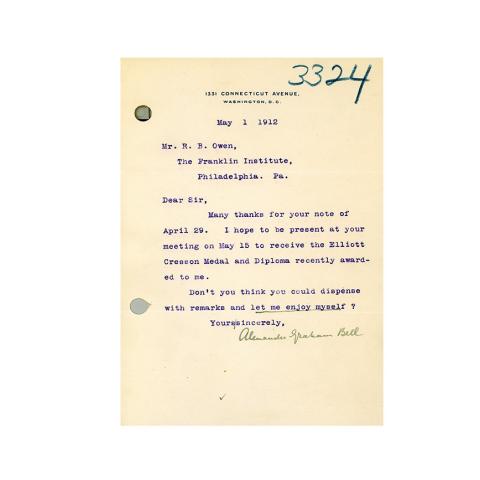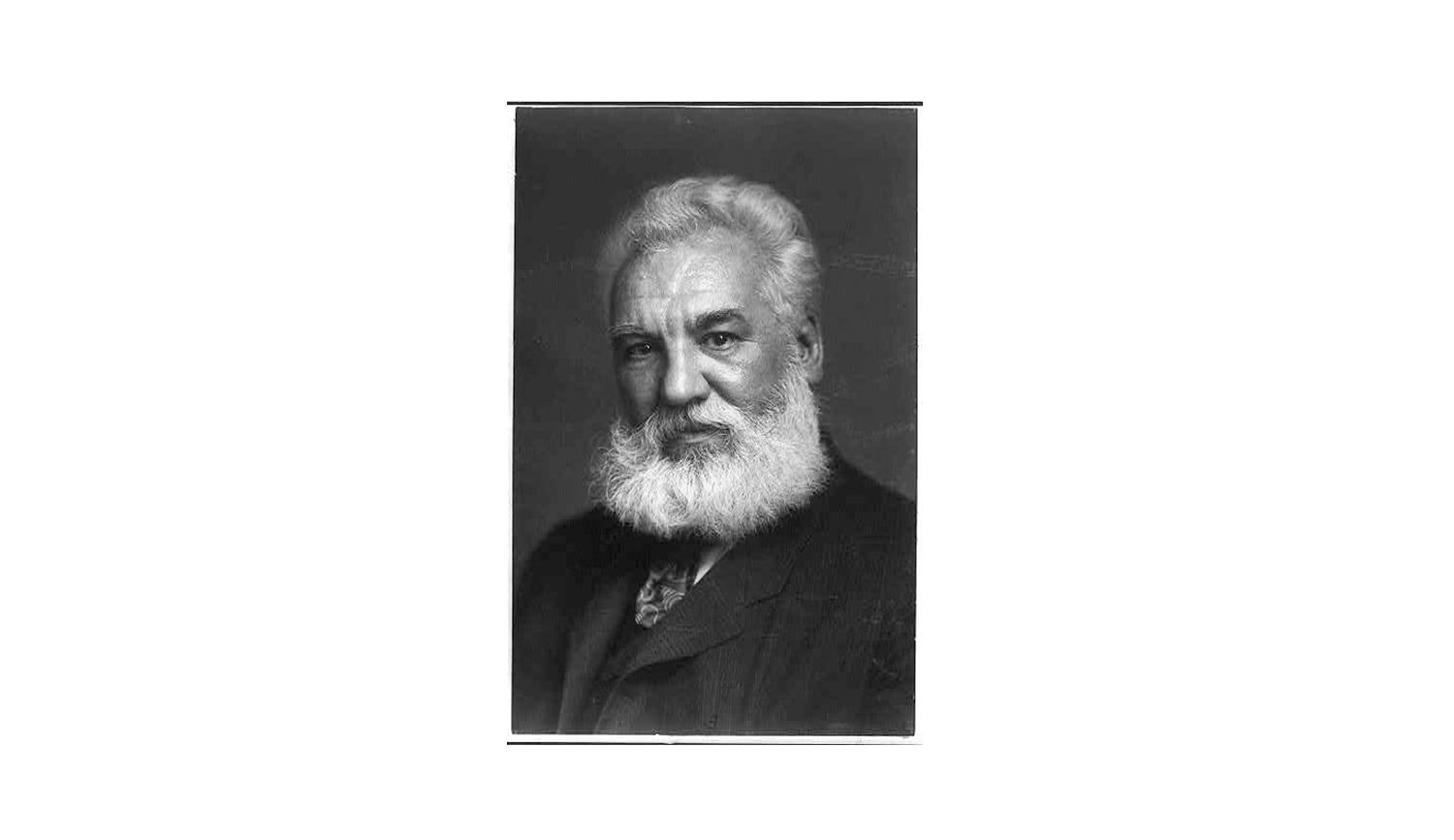
Introduction
Ranked among the most famous inventors in the history of science, Alexander Graham Bell is forever associated with the telephone. Did you know, however, that the telephone was neither his first nor his last innovation?
His Photophone and Graphophone were equally significant in the evolution of voice-to-voice communication technologies. But just who was Alexander Graham Bell? How did he develop his skill and passion for invention?
Call Me Alexander Graham Bell
On March 6, 1847, the Scotsman newspaper brought residents of Edinburgh the news of the birth of Alexander Bell, son of Eliza and Alexander Melville Bell. Coincidentally, the newspaper also announced the upcoming arrival of a telegraph line, which would speed communications between London and Edinburgh. Coming from a long line of Alexanders (both his father and his grandfather responded to this name), Alexander Bell of telephonic fame was known as "Aleck." When he was ten years old, Aleck Bell's household received a young lodger named Alexander Graham. This youth had been a pupil of Alexander Melville's, and drew the respect and admiration of Aleck. Distressed that both of his brothers had two Christian names while he had only one, and worshipful of his household's young lodger, Aleck requested a new name for his eleventh birthday. His father complied with this request, and on March 6, 1858, he raised his glass to toast the birthday boy, newly christening him Alexander Graham Bell.
Call to Service
In 1858, Alexander Melville (called Melville) and Eliza Bell purchased a pleasantly rustic two-storey stucco house in Trinity, located in the environs of Edinburgh. Their neighbors in Trinity included a lively family called Herdman, who operated a nearby flour mill. A number of photographs survive from this and other periods of Aleck's life, due to Melville's contagious fascination with photography. In his early teens, photos and descriptions reveal that Aleck was tall, dark and handsome, with a trademark habit of flicking his long locks back over his shoulders.
The dashing youth was first encouraged to invent at age eleven or twelve, when the rowdy behavior of Aleck and Ben Herdman prompted Ben's father to exasperatedly question the boys, "Why don't you do something useful?" Intrigued by the idea, Aleck asked John Herdman how he could be of use. The man replied that he needed help taking the husks off of wheat. In response, Aleck combined a windmill-like machine consisting of rotation paddles with a nail brush, creating a dehusking machine that was put into operation and used steadily for a number of years. Many years later, Alexander Graham Bell wrote on his youth at the flour mill: "So far as I remember, Mr. Herdman's injunction to do something useful was my first incentive to invention, and the method of cleaning wheat the first fruit."
All in the Family
Alexander Graham's grandfather, Alexander Bell*, had a penchant for play acting. While he never made it as a famous actor, the bit parts he secured in Edinburgh theatricals taught him how to control his breathing and project his voice. With a commanding stage presence and a booming voice, he decided to set up shop as a teacher of elocution. The break-up of his marriage to Elizabeth Bell brought Alexander Bell to London, with his two sons in tow. Melville and David followed in their father's footsteps, aiding him in his attempts at teaching elocution and taking up the practice themselves. Melville's study of elocution brought him back to Edinburgh, where he met Eliza Gray Symonds. Eliza's deafness rallied his sympathy, and her cheerful comportment soon earned his admiration. Eliza was a painter of miniatures and an accomplished pianist, and a little less than a year after they met, she and Melville were married.
Eliza taught her three sons, Melville ("Melly"), Alexander Graham ("Aleck") and Edward ("Ted"), the conventional subjects of reading and arithmetic as well as drawing, painting, and piano playing. The boys communicated with her using English two-handed sign language, and speaking into her clumsy ear trumpet. Aleck was the only one who contrived a method of successfully communicating with his mother, leaning in close to her forehead and speaking in a low, well-modulated voice. Throughout their lives Aleck and Melly would often partner to work on scientific inventions. Ted sadly did not take part in his brothers' scientific experiments; he died of tuberculosis at age eighteen.
*Interesting to Note: In 1847, Alexander Bell wrote a play entitled The Bride, celebrating the value of good manners. The play passed through the hands of his son, David, on its way to David's son Chichester and ultimately to Chichester's closest friend, George Bernard Shaw. Bell's play was the inspiration for Shaw's success, Pygmalion, which would later be adapted by Rogers and Hammerstein into the beloved musical, My Fair Lady. The preface to Shaw's play credits the Bell family, and the setting for Professor Higgins' laboratory is the very street where Alexander Bell worked as an instructor of speech.
The Speaking Machine
Operating under the influence of his father, Aleck became involved in the business of elocution. While he and his brother were completing their studies, their father challenged them to develop their own improved version of the speaking machine. The earliest version of the speaking machine dates back to the eighteenth century, and in the 1820s a more up-to-date version was created by Charles Wheatstone. Their understanding of the human speech pattern, voicebox, and diaphragm aided Alexander Graham and his brother, Melly, in rising to their father's challenge, and the boys used textbooks to learn about anatomy and speech. In the end they did come up with a working speech machine, having gained invaluable knowledge of the organs of speech and the physiology of the human voice along the way. This knowledge would aid Alexander in his later development of the telephone.
Ignorance is Bliss
Hermann von Helmholtz, whose inventions contributed to the scientific renaissance of the 19th century, developed a machine which generated vowel sounds. Alexander Graham Bell investigated this apparatus, which used regulation of tuning fork vibrations to generate its sounds. While Bell did know a great deal about vowel sounds, he knew next to nothing about electricity. This lack of knowledge caused him to form the mistaken idea that Helmholtz's machine actually transmitted vowel sounds, when in actuality it only produced them. However erroneous, this exciting idea prompted Bell to theorize that if vowel sounds could be transmitted over electrical wires, so too could consonant sounds and sounds in general. Bell's dedication to see this invention develop eventually helped drive his determination to construct the telephone.
Best of Philly
Prior to perfecting the telephone, Alexander Graham Bell invented and demonstrated the harmonic telegraph at the Centennial Exposition of 1876, held in Philadelphia's Fairmount Park. This Exposition was attended by Dom Pedro II, then Emperor of Brazil. Bell's principle rival, Elisha Gray, also presented an invention at this Exposition. Bell's device was the last to be reviewed by the Emperor and other distinguished judges. Having rigged up his invention in the East Gallery, Bell took up his stance on one end of the room while the Emperor bent over a receiver positioned at the opposite end. Bell sang into his receiver, and then began reciting Hamlet's well-known "To be, or not to be" monologue. "Aye, there's the rub," he said into one receiver, while the Emperor excitedly repeated the Shakespearean verses he heard on the other side of the room.
A Labor of Love
Alexander Graham's father, Melville Bell, created a phonetic system called Visible Speech, achieving an arrangement that reduced every sound to a visual representation. He used a horseshoe shape to represent the tongue, and manipulated this image to represent different movements of the mouth and thus different sounds. Alexander Graham traveled to Boston to propagate his father's system of Visible Speech, where he met Gardiner Greene Hubbard. One of Hubbard's daughters, Mabel, had lost her hearing after a severe bout of scarlet fever, but with the help of tutor and governess, Mary True, her speech did develop. Mary True and Alexander Graham Bell became acquainted within the circle of Boston elocutionists, and at age sixteen Mary True introduced her young pupil to Alexander Graham.
Letters from Mabel to her mother reveal the budding relationship between herself and "Mr. Bell." Mabel reports that Alexander told her she had a naturally sweet voice, and that she walked through driving rain to get to lessons with him: "I did not want to lose a lesson when each costs so much." When they met in 1873, Mabel was just 15, and in 1877 they married. The wedding was a humble family affair, and took place on a warm July evening in the Hubbard mansion. The pair said "I do" in the very room where Alexander Graham first made Mabel's acquaintance. July of 1877 also brought the founding of the Bell Telephone Company, begun as an unincorporated, volunteer association. Despite his business ventures and scientific breakthroughs, Bell made time to continue his work with the deaf. Notably, he came into contact with Annie Sullivan, and was one of the teachers who worked with Helen Keller. In 1918, Helen wrote to Bell: "You have always shown a father's joy in my successes and a father's tenderness when things have not gone right."
Keeping to Himself
Documents reveal a written discussion between The Franklin Institute's secretary and Alexander Graham Bell, in which the secretary asks for the title of the remarks Bell will be making upon receipt of his Elliot Cresson Medal. Bell's reply asks in a somewhat biting tone if such remarks might be dispensed with, in the interest of allowing him to enjoy himself. Though a handsome man unafraid of the public eye, Bell was always a solitary creature and became increasingly so as he aged. When working on inventions, he became completely consumed by his work, and was also a veritable night owl. His thoughts were most lucid during the early hours of the morning, and he often took to solitary nocturnal rambles. He also had a habit of playing the piano far into the night, though this peculiarity did come as a disturbance to other members of his household.
Surgical Steel
On July 2, 1881, President James A. Garfield was shot in the back while ambling through the Washington railway station. The former Civil War General was then forty-nine years of age and in excellent physical shape, and did sustain the wound wrought by the bullet. Known for the experiments he conducted with metal detectors in England, Alexander Graham Bell was called to the President's bedside. The metal probe which he and a team of assistants worked frantically to perfect did not, however, prove successful in locating the bullet lodged in the President's back, and Garfield died weeks after the assault from infection. Distraught over the President's untimely death, Bell worked tirelessly to create an efficient surgical probe, coming up with a successful model in October of 1881. He named his invention the telephonic probe, and the University or Heidelberg conferred an honorary doctorate of medicine on Bell for his contribution to surgery. The telephonic probe would later be attributed to Dr. John H. Girdner, who was present at Bell's initial demonstration of the probe and later published a paper taking full credit for the invention.
Breathing Easier
Perhaps Bell's most famous post-telephone invention was what he called a vacuum jacket. This so-called vacuum jacket would become widely known as the iron lung, a device that prolonged the lives of victims of polio during the polio epidemic which raged in the late 1940s. Aleck began working on this machine in the aftermath of his son Edward's death; the boy died in infancy due to respiratory problems. The iron lung was an airtight iron cylinder which fitted closely around the torso. Once a patient was strapped into the cylinder, a suction pump forced air in and out of the "iron lung," stimulating the patient's own lungs into action.
Good Vibrations
On March 7, 1876, the United States Patent Office issued Alexander Graham Bell patent No. 174,465. Entitled "Improvement in Telegraphy," this patent came to be described as the most valuable patent ever issued. In 1912, The Franklin Institute recognized Bell's success in achieving the electrical transmission of articulate speech with the Elliot Cresson Medal.
Bell's telephone was able to electrically transmit articulate speech thanks to the collaboration of three main parts: the undulatory current, the electro-magnet, and the armature. In his patent, Bell explains that electrical undulations are created by "gradual changes of intensity exactly analogous to the changes in the density of air occasioned by simple pendulous vibrations."
Bell explains the way in which magnets are capable of producing an undulatory current, describing the interaction between a permanent magnet and an electro-magnet. A permanent magnet is a piece of magnetic material that retains its magnetism after it is removed from a magnetic field, while an electro-magnet is defined as a magnet consisting essentially of a coil of insulated wire wrapped around a soft iron core that is magnetized only when current flows through the wire. When a permanent magnet is caused to approach the pole of an electro-magnet, the permanent magnet induces a current of electricity in the coils of the electro-magnet. When the permanent magnet recedes, that action causes a new current of opposite polarity to appear on the wire. If you cause that permanent magnet to vibrate in front of the electro-magnet, it induces an undulatory current of electricity in the coils of the electro-magnet. How rapidly these undulations repeat corresponds to the rapidity of the vibrations of the magnet. Their polarity corresponds to the direction of the permanent magnet's motion, and their intensity corresponds to the amplitude of the magnet's vibration.
Undulations are caused by the vibration or motion of bodies capable of inducing action. In the case of the telephone, the voice is the capable body that induces undulations. Bell depicts a telephonic circuit in a drawing accompanying his patent, showing a circuit where one armature is across from another. Each armature is loosely attached at one extremity to an electro-magnet, and at the other to the center of a stretched membrane. A cone is used to converge sound vibrations upon the membrane. When a sound is uttered into the cone, that motion sets the membrane in vibration, and the vibration of the membrane in turn causes the armature to take part in the motion. The armature's motion then creates electrical undulations on the circuit. When represented graphically, these vibrations are similar in form to the initial vibrations caused by the sound that was made into the cone. A sound similar to that uttered into the cone is thus heard to proceed from the cone attached to the opposite end of the circuit.
Photo- and Graphophone
The Photophone
In 1880, the French Government awarded Alexander Graham the Volta Prize of 50,000 francs (worth roughly $10,000 at the time) in recognition of his invention of the telephone. Bell put this money to good use, setting up the Volta Laboratory in Washington. This workspace would witness the development of two significant inventions: the photophone and the graphonphone. The photophone allowed for the transmission of sound on a beam of light, a precursor to modern day fiber optics, and Bell believed this device to be his most important invention. He used the photophone to transmit the first wireless telephone message on June 3, 1880.
Bell's photophone used the property of a selenium crystal that made its electrical conductivity dependent on the intensity of its light exposure. The transmitting light beam was created from sunlight by a system of mirror, lens, and a cell to remove heat radiation. The light rays shone on a motion-sensitive mirror which picked up and reacted to sound vibrations. Motion of the mirror created distortions in the light beam it reflected towards a parabolic mirror and this mirror focused the distorted light on the selenium detector at its center. The detector reacted by creating correspondingly interrupted electrical signals. These signals were sent to the magnet of the telephone and converted back to sound in the receiver in the usual way through an electromagnet connected to a diaphragm.
The range of Bell's photophone never extended beyond a few hundred yards, and the device also failed to protect transmissions from outside interferences, such as clouds. These outside interferences disrupted transport by blocking the beams of light necessary for transmission. The principles of the photophone were used by Guglielmo Marconi when he successfully developed wireless telegraphy.
The Graphophone
Originally known as the phonograph, the graphophone was developed in the interest of recording and reproducing sound. This was first achieved by Thomas Edison in 1877, and in 1879 Alexander Graham Bell and his apprentice, Charles Sumner Tainter, began making improvements on Edison's invention. Bell first became interested in the phonograph as a potential aid for teaching the deaf. He found, however, that the tinfoil records used by Edison to record and reproduce sound deteriorated after several uses. Bell and Tainter set out to investigate why this was so, and to ameliorate the problem.
The principle behind both the phonograph and the graphophone was to record speech vibrations onto a disk. Charles Tainter used a lighter substance than Edison for the recording disk, finding that a wax record cut with a chisel-shaped stylus was able to reproduce high-pitched sounds better than Edison's tinfoil record. Tainter cut the wax laterally, producing a zigzag pattern that controlled the vibration of the needle used to play the record. This was found preferable to the up-an-down action of Edison's needle. In the end, Tainter and Bell were unable to produce a fully functional graphophone, and Tainter concluded that their attempts at lateral cutting had failed because the zigzag grooves were too large and their pickup too heavy for the energy of the sound waves.
Tainter and Bell were under a time crunch to make improvements on the graphophone and file patents to take credit for those improvements before Thomas Edison could do the same. Unfortunately, their work was interrupted in 1881 when President Garfield was shot and they worked alongside other scientists to develop an instrument to locate and dislodge the bullet. In order to prevent Edison from finding out about their work and to assure themselves rights to a patent in case someone leaked information, Tainter and Bell packed all their work on the graphophone into a tin box, dated and sealed the box, and placed it in a vault in the Smithsonian Institution. These efforts were somewhat in vain, as success in lateral cutting was ultimately achieved in 1887 by Emile Berliner.
A Matter of Principle
The telephone had several inventors, all of whom built upon the innovations of their predecessors. Bell's patent No. 174,465 both credited him with the invention of the telephone and created a controversy that continues to provoke historians, scientists, and scholars. This controversy centers on the fact that, on the very day Bell filed his patent application, a caveat for a similar invention was filed by Elisha Gray. The caveat is no longer used today, but at the time it was a preliminary document that would have been filed to describe an invention that would eventually be the subject of a formal patent application.
The key similarity between Bell's patent and Gray's is that each describes a "principle of variable resistance," and details a liquid contact transmitter. Bell used such a liquid transmitter to demonstrate his invention at the 1876 exposition in Philadelphia, held in honor of America's centennial year. He also describes both the transmitter and the "principle of varying resistance" in his patent. This transmitter consists of a diaphragm, a needle, and a small cup of water. The cup of water is able to conduct electricity with the addition of a little acid. Speech is projected on the diaphragm, causing the diaphragm to vibrate. The attached needle is thus caused to vibrate in accordance with the speech. The vibrating action causes the needle to dip in and out of the cut of water, thus varying the resistance of the battery circuit. This variation creates the undulating current necessary for the electrical transmission of articulate speech.
Interested in learning more about Alexander Graham Bell? Learn More About His Cresson Award
The most serious charge against Bell was leveled after his patent officer admitted to having shown Bell the caveat submitted by Elisha Gray. This caveat described the "principle of variable resistance," which Bell had yet to develop on his own. The evidence suggests that Bell was able to incorporate Gray's principle into his own patent application before filing it: the variable resistance claim is written in on the margin of Bell's original patent application. Though the courts did sustain Bell's claims and named him the rightful inventor of the telephone, the evidence remains and the controversy lives on.
The electromagnetic receiver described by Bell in patent No. 174,465 is essentially the same as the telephone receivers in use today, and this feature is unique to his patent. Bell was accused of stealing Gray's "principle of variable resistance," a principle that was vital to the development of later electrical transmitters of speech. Though liquid is not used in current receivers, the "principle of variable resistance" played (and continues to play) a key role in the success of the telephone.
Acknowledgement
The Franklin Institute awarded Alexander Graham Bell the Elliott Cresson Medal in the field of Engineering in 1912 for "Electrical Transmission of Articulate Speech." Access the final report of the Committee on Science and the Arts by clicking the thumbnails below.
The endowment of the Franklin Institute Awards Program began with a gift of $1,000 from Philadelphia philanthropist Elliott Cresson to establish the Cresson Medal in 1848. Read more about Elliott Cresson(PDF file, 3.2M), from "The Franklin Institute Donors of the Medals and Their Histories."
Credits
The Alexander Graham Bell project is made possible by support from The Barra Foundation and Unisys.
This website is the effort of an in-house special project team at The Franklin Institute, working under the direction of Carol Parssinen, Senior Vice-President for the Center for Innovation in Science Learning, and Bo Hammer, Vice-President for The Franklin Center.
Special project team members from the Educational Technology department are:
Karen Elinich, Barbara Holberg, Margaret Ennis, Natasha Fedder, and Jay Treat.
Special project team members from the Curatorial department are:
John Alviti and Andre Pollack.
The project's Advisory Board Members are:
Ruth Schwartz-Cowan, Leonard Rosenfeld, Nathan Ensmenger, and Susan Yoon.
Read the Committee on Science and the Arts Report awarding of the Elliott Cresson Medal to Alexander Graham Bell.


